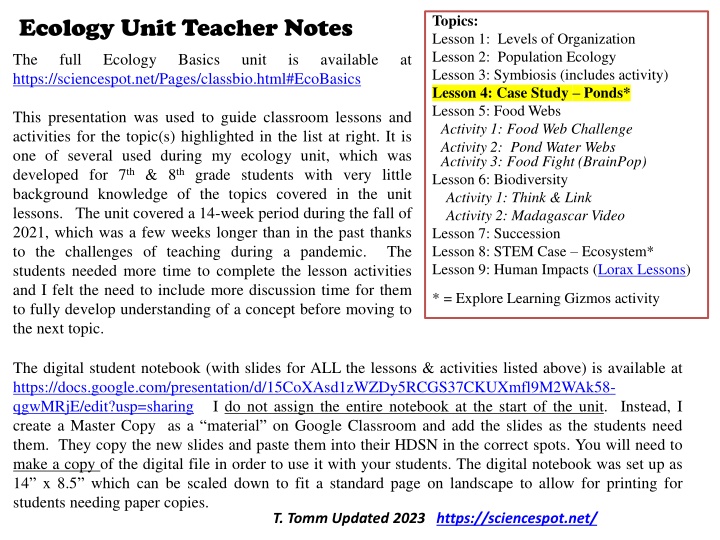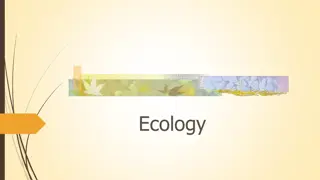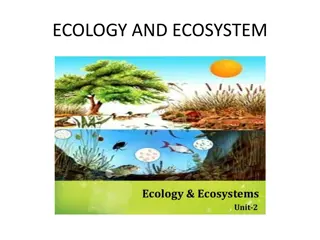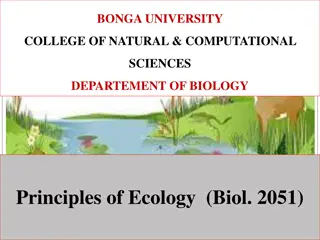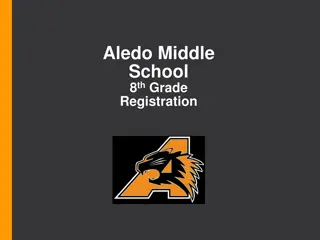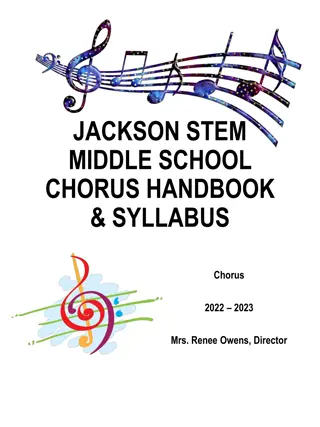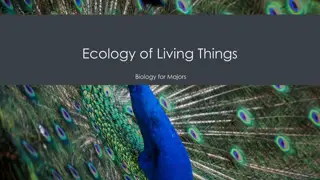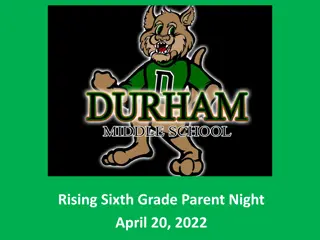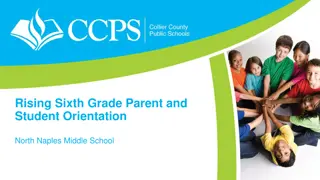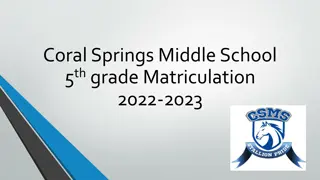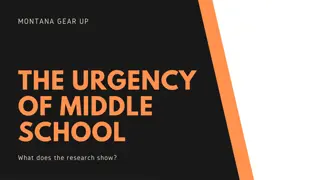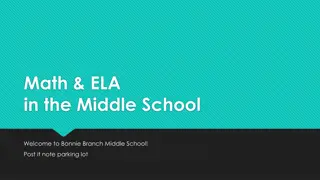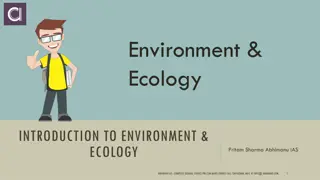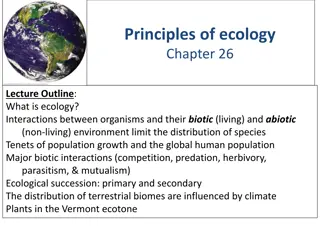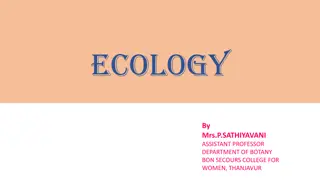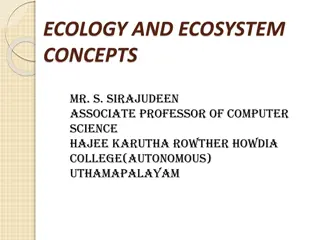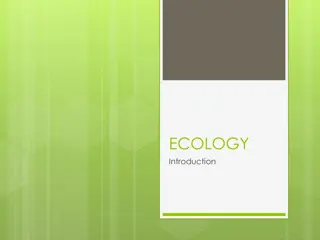Comprehensive Ecology Unit for Middle School Students
Engage 7th & 8th grade students in a 14-week ecology unit covering topics like levels of organization, population ecology, symbiosis, biodiversity, human impacts, and more. Utilize digital notebooks, interactive activities, and exploration tools to enhance learning and understanding. Access resources, vocabulary lists, and learning targets to support effective teaching and assessment.
Download Presentation

Please find below an Image/Link to download the presentation.
The content on the website is provided AS IS for your information and personal use only. It may not be sold, licensed, or shared on other websites without obtaining consent from the author.If you encounter any issues during the download, it is possible that the publisher has removed the file from their server.
You are allowed to download the files provided on this website for personal or commercial use, subject to the condition that they are used lawfully. All files are the property of their respective owners.
The content on the website is provided AS IS for your information and personal use only. It may not be sold, licensed, or shared on other websites without obtaining consent from the author.
E N D
Presentation Transcript
Topics: Lesson 1: Levels of Organization Lesson 2: Population Ecology Lesson 3: Symbiosis (includes activity) Lesson 4: Case Study Ponds* Lesson 5: Food Webs Activity 1: Food Web Challenge Activity 2: Pond Water Webs Activity 3: Food Fight (BrainPop) Lesson 6: Biodiversity Activity 1: Think & Link Activity 2: Madagascar Video Lesson 7: Succession Lesson 8: STEM Case Ecosystem* Lesson 9: Human Impacts (Lorax Lessons) Ecology Unit Teacher Notes The https://sciencespot.net/Pages/classbio.html#EcoBasics full Ecology Basics unit is available at This presentation was used to guide classroom lessons and activities for the topic(s) highlighted in the list at right. It is one of several used during my ecology unit, which was developed for 7th & 8th grade students with very little background knowledge of the topics covered in the unit lessons. The unit covered a 14-week period during the fall of 2021, which was a few weeks longer than in the past thanks to the challenges of teaching during a pandemic. The students needed more time to complete the lesson activities and I felt the need to include more discussion time for them to fully develop understanding of a concept before moving to the next topic. * = Explore Learning Gizmos activity The digital student notebook (with slides for ALL the lessons & activities listed above) is available at https://docs.google.com/presentation/d/15CoXAsd1zWZDy5RCGS37CKUXmfl9M2WAk58- qgwMRjE/edit?usp=sharing I do not assign the entire notebook at the start of the unit. Instead, I create a Master Copy as a material on Google Classroom and add the slides as the students need them. They copy the new slides and paste them into their HDSN in the correct spots. You will need to make a copy of the digital file in order to use it with your students. The digital notebook was set up as 14 x 8.5 which can be scaled down to fit a standard page on landscape to allow for printing for students needing paper copies. T. Tomm Updated 2023 https://sciencespot.net/
Unit Vocabulary Time The last slide in the student digital notebook lists the main vocabulary from each lesson. After each topic, I have students color code the terms and then write definitions. All the definitions from the unit are available on the Quizlet page linked below. https://quizlet.com/28845277/ecology- unit-vocabulary-all-terms-flash-cards/ Learning Targets The next to last slide in the digital notebook is a list of learning targets for the entire unit. Prior to any quiz/test, we review the targets and discuss possible questions that relate to each one. This allows the students to connect the lessons to the learning expectations.
Ecology Basics Lesson 1C: Pond Case Study Simulation available through Gizmos from Explore Learning. Introduction (Left side)
A picture containing text, clipart Description automatically generated Lesson 4 Case Study Lesson 4 Case Study Pond Ecosystem Part A Part A Part B Part B Ecosystem Builder Ecosystem Builder Pond Ecosystem
Case Study Pond Ecosystem Follow these directions to login. Use this username ttomm2023 Click your class period Click your name WAIT for everyone to get logged in! 126S# 126S12345
Slide 4 Left Side Collecting Data Follow the direction to the left of the slide to record water temperature and oxygen concentration. You will also need to keep track of the # of fish you catch for each pond. Click NEW POND and choose one with farms.
Slide 4 Right Side Discussion Questions Use your observations and data to answer the questions. Be prepared to discuss your answers in class. Try for a record! Describe the pond that was the best fishing spot!
Ecology Basics Lesson 3: Pond Case Study Simulation available through Gizmos from Explore Learning. Discussion Questions (Right side)
Not in your notebook! Think About It 1) Animals that live on land obtain their oxygen from the air. How do fish and other animals that live in water get their oxygen? Gills 2) What gas is dissolved in soda to make it bubbly? Carbon Dioxide (CO2) 3) What happens to an open bottle of soda that is allowed to sit for awhile? It will go flat all the dissolved CO2 will separate out of the solution. 4) Does the temperature of the soda affect what happens? Warm soda will lose CO2 faster than a cold soda.
Open your Ecology HDSN & go to Slide 4. Done? You may fix or correct your answers. Not done? Close your laptop and listen. You will need to finish it and see the teacher for the class notes.
Discussion Questions Use your observations and data to answer these questions. 1) List 3 biotic and 3 abiotic factors in a pond ecosystem. Biotic Living things Catfish Trout Other fish Algae Plants Insects & larvae/nymphs Frogs/tadpoles Birds Snakes Abiotic Nonliving things Water Oxygen/air Temperature Sunlight Soil Rocks Chemical compounds from fertilizers & other chemicals Most popular answers
2) How does the oxygen concentration change over 24 hours? Why? Time Time Time Temp Oxygen Temp Oxygen Temp Oxygen 6:00 AM 6:00 AM 6:00 AM 15 5.93 19 5.37 23 5.00 12:00 PM 12:00 PM 12:00 PM 17 7.52 22 6.95 26 6.44 6:00 PM 6:00 PM 6:00 PM 19 9.10 23 8.37 27 7.88 12:00 AM 12:00 AM 12:00 AM 16 7.56 21 6.90 25 6.50 6:00 AM 6:16 AM 6:00 AM 14 5.69 19 5.37 23 5.00 What happens? Oxygen levels and decrease down at night. Increase during the day Hint: What is taking place when the sun is out? Why? Day Night Algae & plants make oxygen by photosynthesis Animals use up oxygen, no photosynthesis
3) How does water temperature affect its ability to hold oxygen? Warm water holds less dissolved oxygen than cold water. Calculate the average temperature and oxygen concentration for each pond listed below. POND A POND B Which pond is warmer? Pond B Temp Oxygen Temp Oxygen 6:00 AM 6:00 AM 15 5.93 23 5.00 12:00 PM 12:00 PM 17 7.52 26 6.44 Which pond has a lower average concentration? Pond B 6:00 PM 6:00 PM 19 9.10 27 7.88 12:00 AM 12:00 AM 16 7.56 25 6.50 6:00 AM 6:00 AM 14 5.69 23 5.00 24.8 16.2 Average Temp = _____ Average Temp = _____ 6.16 7.16 Average Concentration = _____ Average Concentration = _____
4) How does oxygen concentration affect the fish that live in a pond? NO FARMS Temp Oxygen Catfish Trout 6:00 AM 15 5.93 0 0 12:00 PM 17 7.52 3 5 6:00 PM 19 9.10 5 8 Look at your data Most fish overall? More catfish? More trout? Higher oxygen concentration? 12:00 AM 16 7.56 6 14 6:00 AM 14 5.69 9 17 1 FARM Temp Oxygen Catfish Trout 6:00 AM 19 4.77 0 0 12:00 PM 21 6.10 2 3 6:00 PM 23 7.40 6 5 12:00 AM 20 6.18 10 8 Generalist vs specialist 6:00 AM 19 4.81 13 9 Trout need more oxygen, while catfish can survive with less oxygen.
5) How does the presence of farms affect the temperature or oxygen levels in a pond? Why? 1 FARM Temp Oxygen Catfish Trout 4 FARMS Temp Oxygen Catfish Trout 6:00 AM 19 4.77 0 0 6:00 AM 27 2.69 0 0 12:00 PM 21 6.10 2 3 12:00 PM 30 3.50 4 0 6:00 PM 23 7.40 6 5 6:00 PM 31 4.27 9 0 12:00 AM 20 6.18 10 8 12:00 AM 29 3.51 14 0 6:00 AM 19 4.81 13 9 6:00 AM 27 2.69 17 0 The more farms you had, the lower your oxygen levels. Why? Fertilizers and other chemicals can lower oxygen levels. High levels of run off = More sediments in the pond & less light reaching the plants on the bottom
What causes a toxic bloom? Fertilizers cause algal blooms Bacteria decompose dead algae & use up oxygen Low oxygen kills fish What other places contribute to the problem? Yards, golf courses, parks, factories
LOG IN Open the activity and then click LAUNCH ttomm2023 Click the BLUE ARROW. Scroll down to find the 5 questions. Click your class Click your name How did you do? Use your 126S# as the password. Extra time? Try fishing again, look at the Bio Blitz pictures, or work on other work.
Challenge: Which pond will produce the best results? Give it a try! Describe what worked the best for you and your results in the text box to the right of this slide. What temperature worked best warmer or colder? Did you want to start with a higher or lower oxygen concentration? Who was able to catch more trout than catfish?
